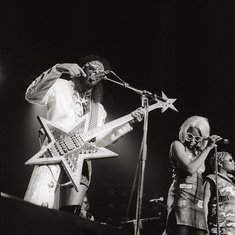|
Era
|
Description
|
Notable Artists/Songs
|
Answer
|
|
Late 19th C.
|
This emotional and generally melodic style of music dealt with themes of romance and intimate relationships. It developed primarily in Tin Pan Alley.
|
Charles K. Harris's "After the Ball"
|
Sentimental Ballad
|
|
1860s
|
It originated in jukes joints the Deep South, often relating to the challenges experience by African Americans. Influences include spirituals, work songs, and field hollers.
|
Ma Rainey, Blind Lemon Jefferson |
Blues
|
|
|
Pieces are typically composed for and performed on piano, and its cardinal trait is its syncopated rhythm.
|
Scott Joplin
|
Ragtime
|
|
|
This genre originated in the African American communities of New Orleans and is characterized by swing and "blue notes", complex chords, call and response, and improvisation.
|
Duke Ellington, Louis Armstrong |
Jazz
|
|
Late '20s-40s
|
Played by a musical ensemble of ten or more musicians in four sections: sax, trumpet, trombone, rhythm. This style dominated dancehalls in the 1940s.
|
Benny Goodman, Glen Miller |
Big Band Swing
|
|
1950s
|
Its origins are fiercely debated, but it is typically though to have arisen in the South where African musical tradition merged with European harmony and instrumentation.
|
Chuck Berry, Little Richard |
Rock and Roll
|
|
Mid-1950s
|
Usually refers to white singers with country roots but were also influenced by Black musicians like BB King. The name of the genre is a portmanteau.
|
|
Rockabilly
|
|
Early 1960s
|
This genre is subdivided into an instrumental form with reverb-heavy electric guitars and a vocal form that focuses on vocal harmonies.
|
The Ventures, The Beach Boys |
Surf Rock
|
|
1964-67
|
A cultural phenomenon where music acts from the United Kingdom contributed to American counterculture and to a brief Anglophilia in America.
|
The Beatles, The Rolling Stones |
British Invasion
|
|
Mid-1960s
|
This genre attempts to blend the sounds of rock with the large library of the pre-existing traditional American music. Or commonly songs written by Bob Dylan.
|
Bob Dylan's "Like a Rolling Stone"
|
Folk Rock
|
|
Late 1960s
|
This rock music genre is centered on perception-altering hallucinogenic drugs and used electronic sound effects, electric organs, instrumental solos, and improvisation.
|
Strawberry Alarm Clock, Jefferson Airplane |
Psychedelic Rock
|
|
Late 1960s
|
This avant-garde subgenre of rock does not follow typical musical rules and can include innovative and strange methods of playing instruments, lyrics, rhythm, and structure.
|
Frank Zappa, Captain Beefheart |
Experimental Rock
|
|
Late 1960s-1970s
|
This form of rock music originated in Southern California and the UK, with simple melodies that relied on lush production value and saccharine subject matter.
|
James Taylor, Bread, Neil Young |
Soft Rock
|
|
Late 1960s
|
This loosely defined genre is characterized by aggressive vocals and distorted electric guitar. It would split into many subgenres by the 1970s.
|
Led Zeppelin, Jimi Hendrix, Cream |
Hard Rock
|
|
Late 1960s-1970s
|
Rather than catchy tunes and danceable beats, this genre focuses on self-expression, experimentation, and the conceptualization of music. Andy Warhol even produced the genre's flagship album: Velvet Underground & Nico.
|
|
Art Rock
|
|
Late 1960s-1970s
|
This broad genre of rock referred to the artistic growth of music as the '60s ended and focus shifted to more poetic lyrics, expressive instrumentation, and music for listening, not dancing.
|
Emerson, Lake & Palmer, Rush |
Progressive Rock
|
|
Late 1960s-1970s
|
This music genre originated in African American communities and focused on a rhythmic groove more than on melody or chord progression.
|
James Brown, George Clinton, Curtis Mayfield |
Funk
|
|
Mid-Late 1970s
|
This dance music genre uses a "four-on-the-floor" beat, string sections, rhythm guitars, and synthesizers. Popular slogans arose that expressed distaste for this "escapist" music.
|
Donna Summer, The Bee Gees, ABBA |
Disco
|
|
Mid-'70s - 1980s
|
These short, fast-paced songs strip away instrumentations and solos and focus primarily on rebelliousness, counterculture, and youthful energy.
|
The Ramones, Sex Pistols, The Clash |
Punk Rock
|
|
Late '70s - 1980s
|
Featuring a wide variety of styles, this genre features strange and sometimes overly artistic artists with distinctive visual styles and quirky music.
|
Blondie, Devo, Talking Heads |
New Wave
|
|
Mid-'80s & Early 1990s
|
This rock genre features distorted electric guitars and typically expresses dour and angsty themes.
|
|
Grunge
|
|
Mid-'80s & Early 1990s
|
This subgenre featured lyrics that express values of American street gangs and hustlers. It has recurrently been accused of promoting disorderly conduct.
|
|
Gangsta Rap
|
|
1980s, primarily
|
This broad genre of hip hop focuses on socially transformative themes, musical expression, and critical examination of political and existential concerns.
|
De La Soul, Fugees, Kendrick Lamar |
Progressive Rap
|
|
1970s-current
|
This term initially referred to the relationship an artist had, or did not have, with a record company. The advent of the Internet led to a glut of these bands, with some critics calling the subgenre a "landfill".
|
The White Stripes, The Strokes, Modest Mouse |
Indie
|

